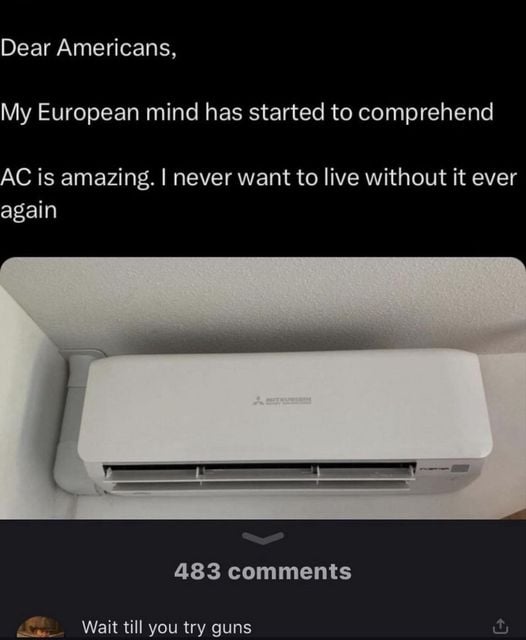this post was submitted on 09 Jul 2024
1029 points (95.6% liked)
Microblog Memes
5467 readers
4 users here now
A place to share screenshots of Microblog posts, whether from Mastodon, tumblr, ~~Twitter~~ X, KBin, Threads or elsewhere.
Created as an evolution of White People Twitter and other tweet-capture subreddits.
Rules:
- Please put at least one word relevant to the post in the post title.
- Be nice.
- No advertising, brand promotion or guerilla marketing.
- Posters are encouraged to link to the toot or tweet etc in the description of posts.
Related communities:
founded 1 year ago
MODERATORS
you are viewing a single comment's thread
view the rest of the comments
view the rest of the comments

These won't even power a small portable AC, if you have a balcony and it's on the south side and you have enough m² to angle the panel halfway properly, you'll be lucky to generate 500 W.
That's only half the power draw of a small AC unit, and doesn't even get into the fact that in most places you cannot hook up a solar to your house without an approved inverter with appropriate safety features (otherwise you'd endanger the linemen in case of an outage). Where I live if you still have an old installation with net metering, you also pay a tax based on the inverter capacity (which is good because net metering is bullshit subsidies from the poor to the landowners).
PV energy is good, but apartments are not a reasonable use-case for it. Residential PV is inherently a tool for privileged house owners, and if PV is to help apartment dwellers it's through grid-scale renewables and dynamic pricing and/or smart grids that provide cheap power for A/C on sunny summer days.
You might not entirely cover the power consumption of an AC, but you can drastically lower the cost of using one by at least partially generating your own electricity. As for the technical aspects I cannot argue at all, as I have no knowledge whatsoever in that regard.
It will take years before you make that money back on the investment though, depending on local taxation and electricity prices. And that's assuming that you have a decent enough orientation in the first place - some people live on the north side of their apartment block!
Always do the maths on PV for your situation, a 25 year positive ROI does not justify a purchase but a 10 year ROI might.
We need more A/C to survive climate change, but the solution can't be "put PV on balconies" because it's highly situational (not everyone has an adequately big south-facing balcony) and won't solve your problems if you could not afford the cooling bills in the first place (the only people who consider a 10 year ROI a good investment are the ones with capital to spare on home improvements). As with all personal renewable tech, it's a cost-saving tool for the well-off, not a structural solution to anything.
Hello fellow countryman!
I think you grossly overestimate the power consumption of a heat pump (a split heat pump that is). On the hottest period of the year so far, ours used about 1,75kWh for a 40m² space.
One or 2 balcony mounted panels (given the right orientation, even with a suboptimal inclination) will easily deliver that much.
You are however right that most apartments can't profit much from solar power... The dynamic pricing however can make the cooling really cheap in the summer months. Just switch to non-dynamic pricing before the winter months to get the best year round price.
Two panels on the balcony of a 40m² studio? The 2x1m 400+ W ones? I did not even have a balcony when I lived in a studio lol. Anyways if you only require 1.75 kWh that's less than a euro of electricity even on fixed pricing. I think the real lesson here is that we haven't had summer yet this year so the AC barely turned on at all.
I just checked on Hubo, their cheapest portable A/C is 7000 BTU, i.e. 2 kW. That means if you had to use it at full tilt for an hour (not exactly an outlandish scenario in the previous years' summers), you'd use more electricity in that hour than you've had all year this year.